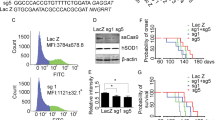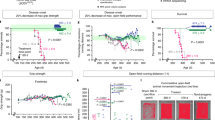Abstract
Mutations in Cu/Zn superoxide dismutase (encoded by SOD1), one of the causes of familial amyotrophic lateral sclerosis (ALS), lead to progressive death of motoneurons through a gain-of-function mechanism. RNA interference (RNAi) mediated by viral vectors allows for long-term reduction in gene expression and represents an attractive therapeutic approach for genetic diseases characterized by acquired toxic properties. We report that in SOD1G93A transgenic mice, a model for familial ALS, intraspinal injection of a lentiviral vector that produces RNAi-mediated silencing of SOD1 substantially retards both the onset and the progression rate of the disease.
This is a preview of subscription content, access via your institution
Access options
Subscribe to this journal
Receive 12 print issues and online access
$209.00 per year
only $17.42 per issue
Buy this article
- Purchase on Springer Link
- Instant access to full article PDF
Prices may be subject to local taxes which are calculated during checkout



Similar content being viewed by others
References
Bruijn, L.I., Miller, T.M. & Cleveland, D.W. Unraveling the mechanisms involved in motor neuron degeneration in ALS. Annu. Rev. Neurosci. 27, 723–749 (2004).
Howland, D.S. et al. Focal loss of the glutamate transporter EAAT2 in a transgenic rat model of SOD1 mutant-mediated amyotrophic lateral sclerosis (ALS). Proc. Natl. Acad. Sci. USA 99, 1604–1609 (2002).
Nagai, M. et al. Rats expressing human cytosolic copper-zinc superoxide dismutase transgenes with amyotrophic lateral sclerosis: associated mutations develop motor neuron disease. J. Neurosci. 21, 9246–9254 (2001).
Newbery, H.J. & Abbott, C.M. Of mice, men and motor neurons. Trends Genet. 17, S2–S6 (2001).
Dykxhoorn, D.M., Novina, C.D. & Sharp, P.A. Killing the messenger: short RNAs that silence gene expression. Nat. Rev. Mol. Cell Biol. 4, 457–467 (2003).
Abbas-Terki, T., Blanco-Bose, W., Deglon, N., Pralong, W. & Aebischer, P. Lentiviral-mediated RNA interference. Hum. Gene Ther. 13, 2197–2201 (2002).
Brummelkamp, T.R., Bernards, R. & Agami, R. A system for stable expression of short interfering RNAs in mammalian cells. Science 296, 550–553 (2002).
Ding, H. et al. Selective silencing by RNAi of a dominant allele that causes amyotrophic lateral sclerosis. Aging Cell 2, 209–217 (2003).
Elbashir, S.M., Martinez, J., Patkaniowska, A., Lendeckel, W. & Tuschl, T. Functional anatomy of siRNAs for mediating efficient RNAi in Drosophila melanogaster embryo lysate. EMBO J. 20, 6877–6888 (2001).
Wiznerowicz, M. & Trono, D. Conditional suppression of cellular genes: lentivirus vector-mediated drug-inducible RNA interference. J. Virol. 77, 8957–8961 (2003).
Gurney, M.E. et al. Motor neuron degeneration in mice that express a human Cu,Zn superoxide dismutase mutation. Science 264, 1772–1775 (1994).
Vila, M. & Przedborski, S. Targeting programmed cell death in neurodegenerative diseases. Nat. Rev. Neurosci. 4, 365–375 (2003).
Raoul, C. et al. Motoneuron death triggered by a specific pathway downstream of Fas. Potentiation by ALS-linked SOD1 mutations. Neuron 35, 1067–1083 (2002).
Gong, Y.H., Parsadanian, A.S., Andreeva, A., Snider, W.D. & Elliott, J.L. Restricted expression of G86R Cu/Zn superoxide dismutase in astrocytes results in astrocytosis but does not cause motoneuron degeneration. J. Neurosci. 20, 660–665 (2000).
Clement, A.M. et al. Wild-type nonneuronal cells extent survival of SOD1 mutant motor neurons in ALS mice. Science 302, 113–117 (2003).
Guillot, S., Azzouz, M., Deglon, N., Zurn, A. & Aebischer, P. Local GDNF expression mediated by lentiviral vector protects facial nerve motoneurons but not spinal motoneurons in SOD1(G93A) transgenic mice. Neurobiol. Dis. 16, 139–149 (2004).
Azzouz, M. et al. Increased motoneuron survival and improved neuromuscular function in transgenic ALS mice after intraspinal injection of an adeno-associated virus encoding Bcl-2. Hum. Mol. Genet. 9, 803–811 (2000).
Finger, S., Heavens, R.P., Sirinathsinghji, D.J., Kuehn, M.R. & Dunnett, S.B. Behavioral and neurochemical evaluation of a transgenic mouse model of Lesch-Nyhan syndrome. J. Neurol. Sci. 86, 203–213 (1988).
Carter, R.J. et al. Characterization of progressive motor deficits in mice transgenic for the human Huntington's disease mutation. J. Neurosci. 19, 3248–3257 (1999).
Kaspar, B.K., Llado, J., Sherkat, N., Rothstein, J.D. & Gage, F.H. Retrograde viral delivery of IGF-1 prolongs survival in a mouse ALS model. Science 301, 839–842 (2003).
Azzouz, M. et al. VEGF delivery with retrogradely transported lentivector prolongs survival in a mouse ALS model. Nature 429, 413–417 (2004).
Lino, M.M., Schneider, C. & Caroni, P. Accumulation of SOD1 mutants in postnatal motoneurons does not cause motoneuron pathology or motoneuron disease. J. Neurosci. 22, 4825–4832 (2002).
Al-Chalabi, A. et al. Recessive amyotrophic lateral sclerosis families with the D90A SOD1 mutation share a common founder: evidence for a linked protective factor. Hum. Mol. Genet. 7, 20452050 (1998).
Wong, P.C. et al. Copper chaperone for superoxide dismutase is essential to activate mammalian Cu/Zn superoxide dismutase. Proc. Natl. Acad. Sci. USA 97, 2886–2891 (2000).
Reaume, A.G. et al. Motor neurons in Cu/Zn superoxide dismutase-deficient mice develop normally but exhibit enhanced cell death after axonal injury. Nat. Genet. 13, 43–47 (1996).
Zeitlin, S., Liu, J.P., Chapman, D.L., Papaioannou, V.E. & Efstratiadis, A. Increased apoptosis and early embryonic lethality in mice nullizygous for the Huntington's disease gene homologue. Nat. Genet. 11, 155–163 (1995).
Elbashir, S.M., Harborth, J., Weber, K. & Tuschl, T. Analysis of gene function in somatic mammalian cells using small interfering RNAs. Methods 26, 199–213 (2002).
Khvorova, A., Reynolds, A. & Jayasena, S.D. Functional siRNAs and miRNAs exhibit strand bias. Cell 115, 209–216 (2003).
Dull, T. et al. A third-generation lentivirus vector with a conditional packaging system. J. Virol. 72, 8463–8471 (1998).
Deglon, N. et al. Self-inactivating lentiviral vectors with enhanced transgene expression as potential gene transfer system in Parkinson's disease. Hum. Gene Ther. 11, 179–190 (2000).
Acknowledgements
We acknowledge P. Colin, F. Pidoux, A. Maillard, C. Sadeghi and V. Padrun for their technical assistance. We are grateful to N. Déglon and W. Pralong for their critical comments throughout this work. We specially thank J. Iovanna for biosafety level 2 laboratory accommodation at Marseille. This work was supported by the ALS Association (ALSA), the Swiss National Science Foundation and the European Union contract LSHM-CT-2003-503330 (APOPIS).
Author information
Authors and Affiliations
Corresponding author
Ethics declarations
Competing interests
The authors declare no competing financial interests.
Supplementary information
Supplementary Fig. 1
Key components of the motoneuron cell death machinery are not modified by LV-shSOD1. (PDF 2665 kb)
Supplementary Fig. 2
LV-shSOD1 does not change the expression level of endogenous SOD1 in SOD1G93A transgenic mice. (PDF 1432 kb)
Supplementary Fig. 3
Gene replacement strategy for pan-silencing therapeutic strategy. (GIF 212 kb)
Rights and permissions
About this article
Cite this article
Raoul, C., Abbas-Terki, T., Bensadoun, JC. et al. Lentiviral-mediated silencing of SOD1 through RNA interference retards disease onset and progression in a mouse model of ALS. Nat Med 11, 423–428 (2005). https://doi.org/10.1038/nm1207
Received:
Accepted:
Published:
Issue Date:
DOI: https://doi.org/10.1038/nm1207
This article is cited by
-
Selective removal of misfolded SOD1 delays disease onset in a mouse model of amyotrophic lateral sclerosis
Cellular and Molecular Life Sciences (2023)
-
The deletion of mutant SOD1 via CRISPR/Cas9/sgRNA prolongs survival in an amyotrophic lateral sclerosis mouse model
Gene Therapy (2020)
-
Premature termination codons in SOD1 causing Amyotrophic Lateral Sclerosis are predicted to escape the nonsense-mediated mRNA decay
Scientific Reports (2020)
-
C10orf99 contributes to the development of psoriasis by promoting the proliferation of keratinocytes
Scientific Reports (2018)
-
Inhibition of breast cancer cell proliferation and tumorigenesis by long non-coding RNA RPPH1 down-regulation of miR-122 expression
Cancer Cell International (2017)



